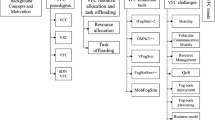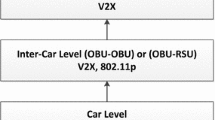Abstract
The main objective of vehicular ad hoc networks (VANETs) is to improve driver safety and traffic efficiency. Most of VANET applications are based on periodic exchange of safety messages between nearby vehicles and between vehicles and nearby road side communication units (e.g., traffic lights, roadside lights etc.). This periodic communication generates huge amount of data that have typical storage, computation, and communication resources needs. In recent years, there have been huge developments in automotive industry, computing, and communication technologies. This has led Vehicular Cloud Computing (VCC) as a solution to satisfy the requirements of VANETs such as computing, storage, and networking resources. Fog computing is a standard that comprehends cloud computing and related services to the proximity of a network. Since VANET applications have special mobility, low latency, and location awareness requirement. Fog computing plays a significant role in VANET applications and services. In this paper, we present real-time applications of VANET that can be implemented using fog computing.
Similar content being viewed by others
References
Bai, F., Krishnan, H., Sadekar, V., Holl, G. and Elbatt, T. (2006) Towards characterizing and classifying communication-based automotive applications from a wire- less networking perspective. IEEE Workshop on Automotive Networking and Applications (AutoNet), pp. 1–16.
S. Yousefi, M. Fathy (2006) Vehicular Ad-hoc NETworks (VANETs): Challenges and Perspectives. 6th International Conference on ITS Telecommunications, IEEE, pp. 761–766.
S. Biswas, R. Tatchikou and F. Dion (2006) Vehicle-to-Vehicle wireless communication protocols for enhancing highway traffic safety. IEEE Communication Magazine, 44(1), pp. 74–82.
D. Jiang, V. Taliwal, A. Meier, W. Holfelder and R. Herrtwich. (2006) Design of 5.9 GHz DSRC-based vehicular safety communication IEEE Wireless Communications, 13(5), pp. 36–43.
M. Whaiduzzaman, M. Sookhak, M. Gani. (2014) A survey on Vehicular cloud computing Journal of Network and Computer applications, 40(1), pp. 325–344.
I. Stojmenovic, S. Wen. (2014) The Fog Computing Paradigm: Scenario and security Issues Proceedings of the 2014 Federated Conference on Computer Science and Information Systems (FedCSIS’14), Warsaw, Poland, pp 8–16.
K. Kai, W. Cong, L. Tao (2016) Fog computing for Vehicular Ad hoc Networks: Paradigms, Scenarios and Issues The Journal of China Universities of Posts and Telecommunications, 23(2), Elsevier, pp. 56–96
M. Eltoweissy, S. Olariu, M. Younis. (2010) Towards autonomous Vehicular clouds Ad Hoc Networks, Berlin, Germany, springer, pp 1–16.
S. Olariu, T. Hristov, G. Yan (2013) The next paradigm shift: from vehicular networks to vehicular clouds Basagni S, Conti M., Giordano S. et al. mobile Ad hoc Networking: cutting edge directions, 2nd edition, John wiley sons
T. H. Luan, L. X. Gao, Y. **ang (2015) Fog computing: focusing on mobile users at the edge ar**v:1502.0181v1
O. T. T. Kim, N. Dang. Tri, V. D. Nguyen, N. H. Tran, C. S.Hong (2015) A shared Parking Model in Vehicular Network Using Fog and Cloud environment 17th Asia Pacific Network Operations and Management Symposium (APNOMS), Busan, pp. 321–326.
M. Firdhous, O. Ghazali, S. Hassan (2014) Fog computing: will it be the future of cloud computing? Proceedings of the 3rd International Conference on Informatics and Applications (ICIA’14), Kuala Terengganu, Malaysia, pp. 8–15.
F. Bonomi (2011) Connected Vehicles, Internet of things and fog computing Proceedings of 8th ACM international Workshop on Vehicular Inter-Networking (VANET’11), Las Vegas, USA.
S. H. Yi, C. Li, Q. Li (2015) A Survey of fog computing, concepts, applications and Issues Proceedings of the 2015 workshop on mobile big data (MobiData’15), Hangzhou, china, pp 37–42.
L. M. Vauero, L. Rodero Merino (2014) Finding your Way in the Fog: towards a Comprehensive Definition of Fog computing ACM SIGCOMM computer communication Review, 44(5), pp 27–32.
N. K. Giang, c. M. Victor, L. Rodger (2016) On Develo** Smart Transportation Applications in Fog Computing Paradigm Proceedings of the 6th ACM Symposium on development and Analysis of Intellegent Vehicular Networks and Applications (DIVANet’16), New York, USA, pp. 91–98.
S. Sarkar, s. Misra (2016) Theoretical modelling of fog computing: a Green Computing to support IoT Applications IET Networks 5(2), pp. 23–29.
D. Jiang, L. Delgrossi (2008) IEEE 802.11p: Towards an International Standard for Wireless Access in Vehicular Environments Vehicular Technology Conference, VTC Spring 2008, IEEE, pp 2036–2040.
Author information
Authors and Affiliations
Corresponding author
Editor information
Editors and Affiliations
Rights and permissions
Copyright information
© 2018 Springer Nature Singapore Pte Ltd.
About this paper
Cite this paper
Grover, J., Jain, A., Singhal, S., Yadav, A. (2018). Real-Time VANET Applications Using Fog Computing. In: Somani, A., Srivastava, S., Mundra, A., Rawat, S. (eds) Proceedings of First International Conference on Smart System, Innovations and Computing. Smart Innovation, Systems and Technologies, vol 79. Springer, Singapore. https://doi.org/10.1007/978-981-10-5828-8_65
Download citation
DOI: https://doi.org/10.1007/978-981-10-5828-8_65
Published:
Publisher Name: Springer, Singapore
Print ISBN: 978-981-10-5827-1
Online ISBN: 978-981-10-5828-8
eBook Packages: EngineeringEngineering (R0)




